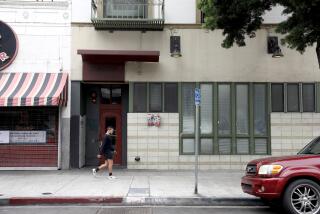Under Chapter 11 Plan, New Owners for Wilshire Courtyard
Wilshire Courtyard, one of the largest office complexes built in Los Angeles in the 1980s, appears destined for new ownership under a bankruptcy court settlement expected to be approved in early April.
Parties involved in the bankruptcy have agreed to a settlement that is scheduled to be reviewed by the federal bankruptcy court in Los Angeles on April 7, said Robert White, an attorney for the creditors.
Provided the court approves the settlement as expected, White said, the new owners of the 967,000-square-foot Wilshire Courtyard complex will assume ownership of the property in mid-April, ending bankruptcy proceedings that have lasted for more than a year.
The new majority owners of the property, which is considered the premier office building in the Miracle Mile district, would be a partnership of investors led by New York-based Blackstone Real Estate Advisors.
The Blackstone-led group, which would own 99% of the property, includes the downtown Los Angeles firm of McCarthy Cook & Co. as well as units of Merrill Lynch, Goldman Sachs & Co., and Los Angeles-based Oaktree Capital Management. The remaining 1% will be owned by a partnership led by Los Angeles developer Jerry Snyder, who built the complex.
The emergence of Wilshire Courtyard from its Chapter 11 bankruptcy would conclude what White described as “one of the largest single-asset bankruptcies ever” in Los Angeles County. The project was completed in 1987 at a cost of $300 million by a partnership led by Snyder, who is credited with helping restore the Miracle Mile through the development of Wilshire Courtyard and the rehabilitation of other office buildings nearby. Snyder is known for other high profile office developments as well, including the Water Garden in Santa Monica.
Snyder’s partnership later sold its interest in the building to LaSalle Partners at a substantial profit, when L.A. office property values were at a pre-recession high, but the Snyder partnership retained technical title to the property in a complex transaction, called a convertible second mortgage, designed to reduce capital gains taxes for the seller.
By the time the first mortgage of $165 million came due in July 1996, Wilshire Courtyard was worth considerably less than was owed on the property, which also carried a $200-million second mortgage. After six months of negotiations during which Snyder and lenders could not reach an agreement to restructure the debt, Snyder’s partnership filed for bankruptcy in January 1997 to avoid foreclosure. The Blackstone group then bought a majority interest in the mortgage from the former lender, Bank of America. The new owners would not disclose the price they paid for the debt, but they said it was substantially below the $165-million face amount of the first mortgage.
Snyder, who still owns other properties in the neighborhood east of Beverly Hills, including Museum Square and the E! Entertainment building, confirmed that the Wilshire Courtyard change of ownership appears imminent and that the parties have agreed to terms.
“We have reached an agreement with the new owners of the note [the debt] that is satisfactory to everyone,” Snyder said. “I think on April 7 it will be done.”
Edward Cook said the Wilshire Courtyard property will be the fourth California office building that he and partner Tom McCarthy have acquired since forming a joint venture with the Blackstone Group in 1996 to buy office properties. Since last November, McCarthy Cook has been the court-appointed creditor-in-charge of Wilshire Courtyard, overseeing property management and leasing.
Cook said one of the new owners’ first orders of business will be to market the office complex aggressively to fill its approximately 200,000 square feet of vacant space. While the Miracle Mile remains one of L.A.’s relatively soft office markets despite the commercial real estate comeback, brokers believe the market is poised for a recovery. They say higher rents in other Westside neighborhoods will push tenants farther east and the general economic recovery will continue to increase demand for office space. They consider Wilshire Courtyard one of the buildings most likely to benefit as the overall market improves.
“It’s the premier building in the Miracle Mile, no doubt,” said broker Vincent Pellerito of Cushman Realty Corp. He cited the campus-like setting of the complex, its on-site gym, fountains and landscaping among the building’s attractions.
None of those features, however, exempted Wilshire Courtyard from the ups and downs of the Southern California real estate market through the last 10 years.
“It was no different from many other high quality assets bought or built in the 1980s that were financed at the top of the market, and in light of the adjustment in values of the early to mid 1990s, were determined to be over-leveraged,” said Gary Sumers, managing director of Blackstone.
Now that the market has turned again, Sumers added, the new owners believe Wilshire Courtyard is a good deal for the investors.
More to Read
Inside the business of entertainment
The Wide Shot brings you news, analysis and insights on everything from streaming wars to production — and what it all means for the future.
You may occasionally receive promotional content from the Los Angeles Times.










